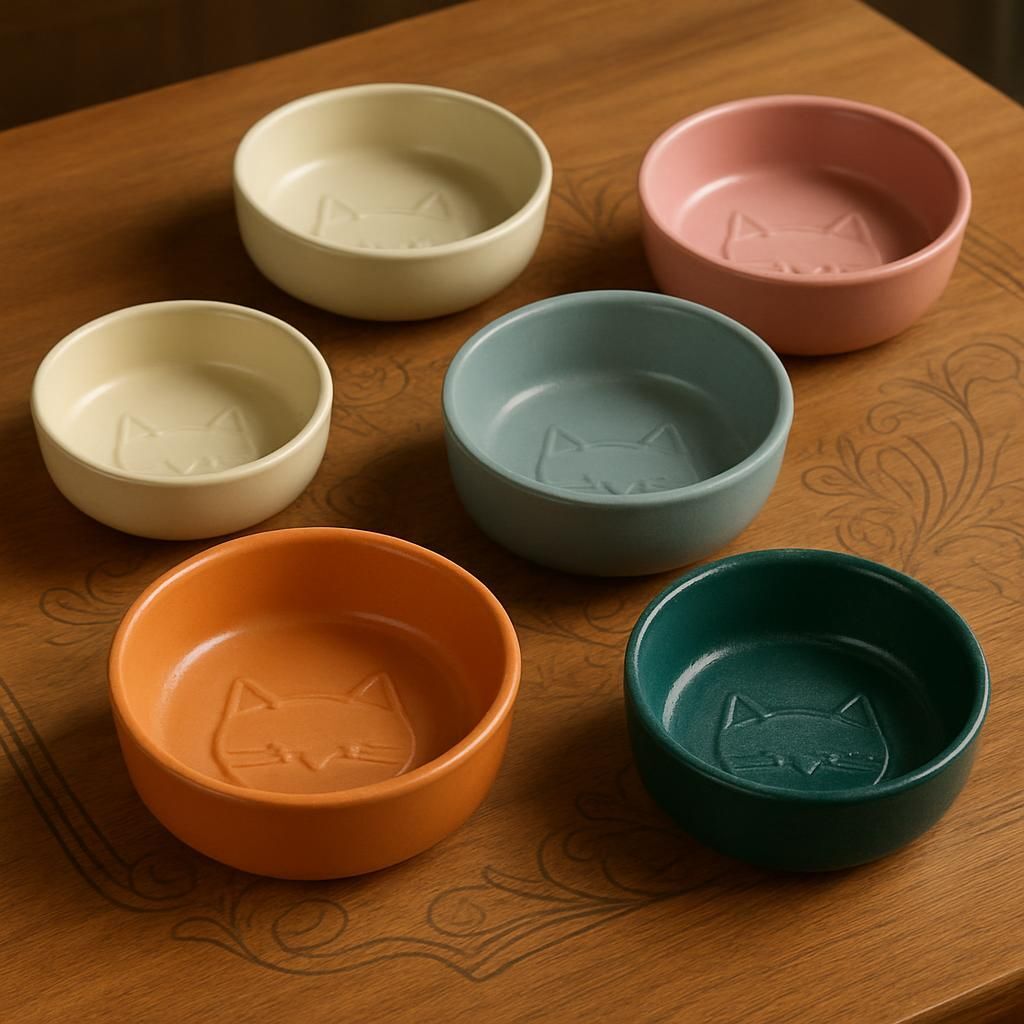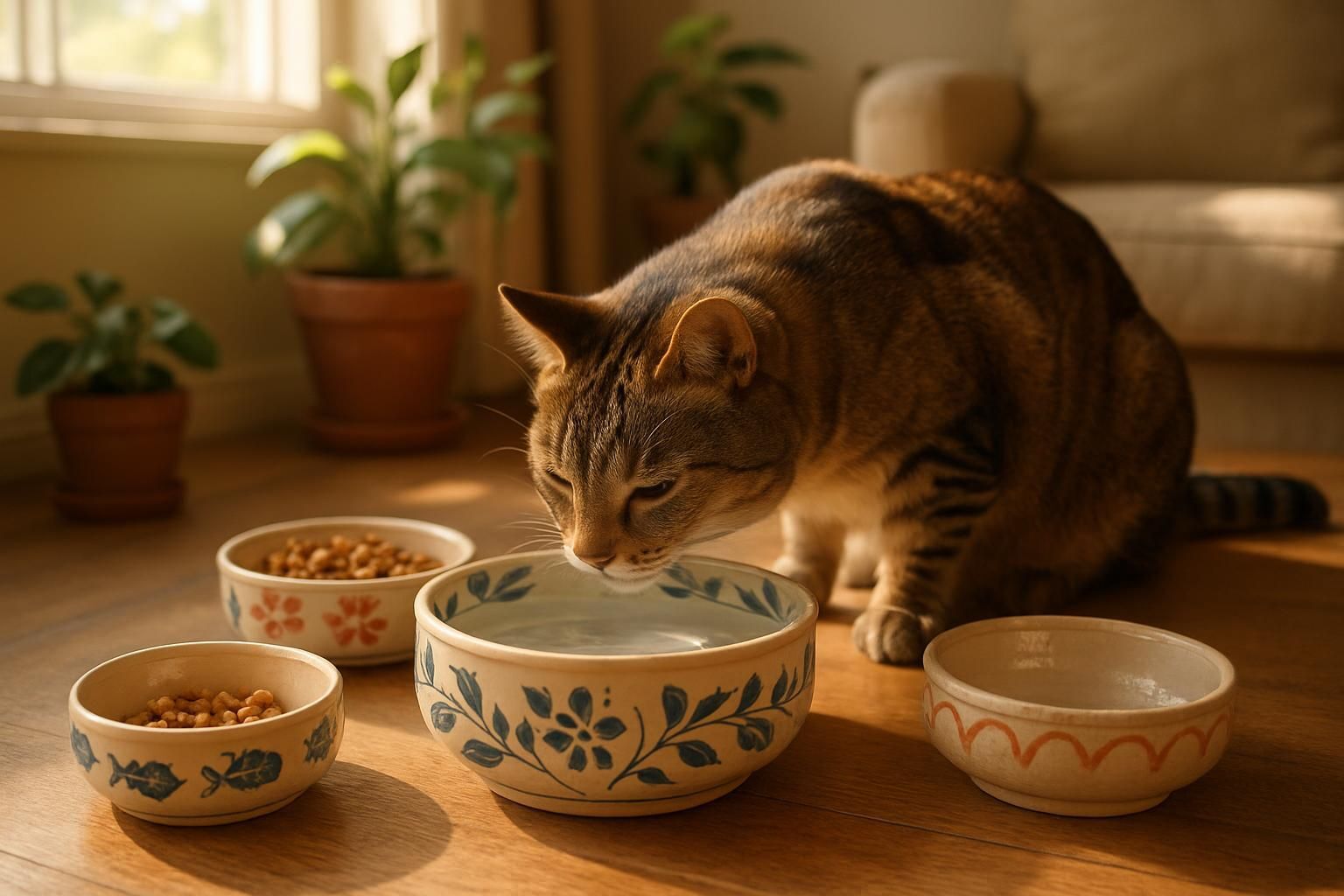When choosing feeding dishes for their cats, pet owners often face the challenge of balancing health risks, safety, and aesthetic appeal. Ceramic bowls are a popular choice due to their weight and stylish designs, but concerns about material quality and potential contamination linger. Cats, known for their sensitive systems and rigorous eating habits, require bowls that not only look good but also protect them from harmful substances, germs, and discomfort. This article explores the complex safety profile of ceramic cat bowls, comparing them to alternatives like stainless steel and glass, while offering practical guidance for selecting, inspecting, and maintaining feeding vessels. With the right knowledge, pet owners can confidently provide mealtime setups that support their cats’ well-being and daily comfort.
Are Ceramic Bowls Safe for Cats? Key Concerns for Cat Owners 🐾
Why Bowl Safety Matters for Your Cat’s Health and Comfort
Choosing the right feeding bowl goes beyond simply providing food and water. For cats, bowl safety directly impacts digestive health, behavior during mealtime, and even long-term well-being. Bowls can harbor bacteria and germs if materials are porous or damaged, leading to infections or upset stomachs. Additionally, bowls that tip too easily or cause discomfort affect a cat’s eating habits, sometimes causing stress or avoidance. Pet owners must consider material durability, surface safety, and the risk of chemical exposure when picking feeding bowls.
From a comfort perspective, the bowl’s weight is crucial; lightweight dishes can slide or spill, potentially discouraging cats from eating. Rough or chipped edges may irritate tongues or gums. Moreover, certain materials have a higher chance of retaining food residues or moisture, creating unsafe environments. Understanding these factors enables caregivers to select bowls that promote safe, enjoyable feeding.
-
🐱 Avoid materials with known toxic risks
-
🧼 Choose bowls with easy cleaning features to limit bacteria
-
🛡️ Prioritize stable and sturdy designs to minimize spills
-
🔍 Inspect regularly for damage that may harm cats
Ceramic Cat Bowls: Popularity, Aesthetics, and Cleaning Benefits
Ceramic bowls have gained popularity among cat owners largely due to their visual appeal and practical advantages. These dishes often feature unique colors and patterns, easily matching home décor while offering a weighted base that resists tipping. Compared to plastic dishes, ceramic options typically provide a non-toxic surface that doesn’t absorb odors or stains if properly glazed.
Ceramics can also be dishwasher safe, simplifying cleaning and minimizing bacteria buildup. Their smooth surfaces limit places where food debris lodges, unlike some textured plastics. Pet owners appreciate that ceramic bowls can be sized and shaped specifically for cats’ needs, accommodating the delicate structure of a cat’s muzzle.
-
🎨 Wide range of designs and colors for personalized style
-
⚖️ Heavier than plastic, providing better stability
-
✅ Dishwasher safe and easy to clean
-
✨ Non-porous when glazed correctly, limiting bacteria growth

Understanding Ceramic Bowl Materials and Safety Standards for Cats
Types of Ceramic Used in Cat Bowls: Earthenware, Stoneware, and Porcelain
Ceramic cat bowls come primarily in three types according to the fired material and density: earthenware, stoneware, and porcelain. Each type varies in strength, porosity, and glaze compatibility, which influence their safety and durability.
Earthenware is the most common and usually fired at lower temperatures. It tends to be more porous and less durable, increasing the chance of cracks and bacterial infiltration if improperly glazed. Stoneware is fired hotter and is denser, making it more resistant to chips and moisture absorption. Finally, porcelain is the highest-fired and most refined, producing a very hard, smooth, and often translucent ceramic ideal for non-toxic, sealed surfaces.
-
🌡️ Earthenware: Low firing, porous, prone to chips
-
🔥 Stoneware: Medium-high firing, denser, durable
-
⚪ Porcelain: High firing, very hard, least porous
-
🛠️ Firing temperature and density directly affect safety
How Firing Temperatures and Material Density Impact Durability and Safety
Firing temperature determines the ceramic’s porosity and hardness. Higher firing leads to stronger materials that better resist cracking and absorbing liquids, essential to prevent bacteria growth. A ceramic bowl fired at appropriate temperatures with a tight molecular structure will have fewer microscopic holes, reducing harmful contamination risks.
Low firing temperatures often result in earthenware ceramics, which remain somewhat porous. Without a high-quality glaze, these dishes may harbor germs and become stained or cracked more easily. Conversely, porcelain’s high firing makes it ideal but sometimes more expensive or more fragile to impact. Understanding these factors helps pet owners select bowls that maximize longevity and safety.
|
Ceramic Type ⚠️ |
Firing Temp. (°C) 🌡️ |
Porosity |
Durability |
Suitability for Cats |
|---|---|---|---|---|
|
Earthenware |
1000-1150 |
High |
Low |
Basic use, careful with glaze quality |
|
Stoneware |
1150-1300 |
Low |
High |
Recommended – more durable and safe |
|
Porcelain |
1200-1400 |
Very Low |
Very High |
Best for safety and hygiene |
Lead-Free and Food-Safe Glazes in Ceramic Cat Bowls: What to Look For
Glazes protect ceramic surfaces by sealing microscopic pores and creating smooth, attractive finishes. However, the glaze composition plays a critical role in a bowl’s safety. Lead, historically used in some ceramic glazes, can leach into food and water, posing serious health risks to cats, who are extremely sensitive to heavy metal poisoning.
Lead contamination symptoms in cats may include vomiting, diarrhea, seizures, or lethargy and require urgent veterinarian care. Therefore, identifying non-toxic, lead-free glazes is essential. Bowls certified by organizations such as the FDA or labeled explicitly “food safe” and “non-toxic” offer greater peace of mind. Imported or vintage ceramic bowls without clear safety standards should be avoided.
-
✔️ Look for “lead-free” and “food safe” labels
-
✔️ Prefer FDA-approved or certified ceramic cat bowls
-
❌ Avoid unmarked, old, or foreign imports without safety info
-
✔️ Purchase from trusted brands with transparency
Health and Safety Risks of Ceramic Cat Bowls: What Cat Owners Should Know 🛡️
Lead Contamination and Toxic Chemical Leaching: Dangers in Low-Quality Ceramics
Lead poses a toxic hazard especially found in some older or low-quality ceramic cat bowls, where improper glazing allows lead particles to enter food or water. Cats are more vulnerable to lead poisoning due to their metabolism and size. Even small amounts of lead intake can cause severe neurological damage and long-term health issues.
Besides lead, other chemical leachates from unstable or improperly tested glazes include cadmium and other heavy metals. Pet owners must recognize that quality control varies, and unchecked ceramics, often found online or in discount stores, may hide these hazards. A veterinarian may advise screening for lead poisoning if a ceramic dish is suspected as a source.
-
⚠️ Lead exposure symptoms: vomiting, tremors, behavioral changes
-
⚠️ Prefer chemically tested, food-grade ceramic dishes
-
⚠️ Avoid cracked or worn bowls with glaze degradation
Chips, Cracks, and Crazing: Bacterial Hazards and Choking Risks
Physical damage like chips, visible cracks, and crazing (fine cracks in glazes) can create hidden pockets for bacteria to thrive. These areas resist proper cleaning and can harbor pathogens that cause digestive issues or infections.
Additionally, chipped fragments may unintentionally break off and become choking hazards or damage cats’ mouths. Such damage also compromises the ceramic’s surface integrity, potentially increasing chemical leaching risks from glaze beneath the surface. Regular inspection of ceramic bowls is vital to maintain safety.
-
🔍 Inspect bowls often for chips, cracks, & crazing
-
🧼 Replace any damaged bowls immediately
-
⚠️ Watch for small ceramic shards that may fall off
-
❗ Use smooth, intact dishes to minimize bacteria buildup
Allergic Reactions and Sensitivities to Ceramic Glazes in Cats
Though rare, some cats may develop sensitivities or allergic reactions to particular ceramic glaze ingredients. Reactions may manifest as oral irritation, excessive salivation, or behavioral aversion to eating. Cats with sensitive tongues or dental issues may react to the bowl’s texture if the glaze surface feels rough or uneven.
Opting for highly polished, food-safe glazed cat bowls reduces these risks. If a cat shows signs of discomfort or avoids ceramic dishes, considering alternative materials with smoother finishes might be beneficial.
|
Risk Factor ⚠️ |
Potential Issue |
Signs to Watch 🐱 |
Owner Action |
|---|---|---|---|
|
Lead in glaze |
Poisoning |
Vomiting, lethargy, tremors |
Switch to certified lead-free bowls |
|
Chips & cracks |
Bacteria harboring, choking |
Behavioral changes, mouth sores |
Replace damaged bowls immediately |
|
Glaze irritation |
Allergic reactions |
Salivation, avoidance |
Test alternative smooth bowl materials |
How to Choose, Inspect, and Maintain Ceramic Bowls Safely for Your Cat 🧼
Tips for Identifying Safe Ceramic Bowls: Certifications, Labels, and Trusted Brands
Choosing safe ceramic bowls involves verifying quality through recognized certifications and brand reputation. Trusted manufacturers openly provide information about firing temperatures, glaze compositions, and compliance with FDA or similar food safety standards, reassuring pet owners about product safety.
When shopping, pet owners should:
-
🔎 Check for “lead-free” and “non-toxic” on packaging
-
🔎 Choose bowls explicitly marked “food safe” or FDA-approved
-
🔎 Prefer US-based or well-reviewed manufacturers with transparency
-
🔎 Read customer reviews emphasizing long-term durability and cat comfort
Brands focusing on pet safety often provide warranty or replacement guarantees for damaged products—an important sign of commitment to animal welfare.
Routine Inspection: Spotting Cracks, Chips, and Glaze Damage in Cat Bowls
Daily or weekly inspections can detect early signs of damage that compromise a ceramic bowl’s safety. Look for:
-
😿 Hairline cracks or crazing visible on surfaces
-
😿 Rounded or sharp chips on edges or rims
-
😿 Dull, scratched, or peeling glazes that can trap bacteria
-
😿 Areas stained or showing abrupt texture changes
Failure to detect these issues might lead to increased health risks for cats, necessitating the replacement of ceramic dishes. Some pet owners use magnifying lenses or bright light to aid in inspection.
Cleaning and Hygiene Best Practices to Prevent Bacteria in Ceramic Bowls
Proper cleaning routines are key to limiting bacterial growth, especially because ceramic may develop microscopic crazing over time where germs thrive. Recommended practices include:
-
🧽 Daily washing with hot water and mild dish soap
-
🧽 Using dishwasher-safe bowls when possible for thorough cleaning
-
🧽 Avoiding abrasive scrubbers that damage glaze
-
🧽 Periodic deep sanitization with diluted vinegar or pet-safe disinfectants
Replacing bowls every 1-2 years can also maintain hygiene and ensure durability. Non-slip mats under bowls reduce movement, minimizing breakage risks during cleaning or use.
Ceramic vs. Other Cat Bowl Materials: Making the Best Choice for Your Pet 🐱
Ceramic Bowl Advantages: Weight Stability, Non-Porous Surface, and Style Options
Ceramic bowls offer notable benefits that appeal to pet owners and cats alike. Their substantial weight provides stability during feeding, preventing tipping or sliding, important for cats that may be playful or vigorous eaters. When glazed properly, ceramics are effectively non-porous, reducing bacterial absorption and odors compared to plastics.
Moreover, the aesthetic appeal of ceramic dishes fits well into modern homes, with diverse colors, shapes, and designs. This versatility allows caregivers to select bowls that blend elegantly with interiors without sacrificing animal-friendly features.
-
🔸 Heavy and stable to prevent spills
-
🔸 Smooth, sealed surface less porous than plastic
-
🔸 Beautiful, customizable designs & colors
-
🔸 Often dishwasher-safe for easy cleaning
Comparing Hygiene and Durability: Ceramic vs Stainless Steel and Glass Cat Bowls
Stainless steel and glass represent two popular alternatives with distinct pros and cons compared to ceramic cat bowls:
|
Material 🐾 |
Hygiene 🧴 |
Durability 🛠️ |
Safety Concerns ⚠️ |
Weight & Stability ⚖️ |
|---|---|---|---|---|
|
Ceramic |
Good when intact; can harbor bacteria in cracks |
Moderate; can chip or crack |
Lead/glaze leaching if low quality |
Heavy and stable |
|
Stainless Steel |
Excellent; non-porous, easy to sanitize |
Very high; resistant to damage |
Rarely causes allergies; may rust if low grade |
Light to medium; less stable than ceramic |
|
Glass |
Excellent; non-porous and easy to clean |
Fragile; prone to shattering |
No leaching; breakage hazard |
Moderate; heavier than steel but less than ceramic |
While stainless steel cat bowls excel in durability and hygiene, their lighter weight can sometimes cause movement during use. Glass dishes provide excellent safety but pose breakage risks. Ceramic bowls strike a balance but require care regarding glaze quality and physical damage.
When Are Ceramic Bowls Recommended for Cats—and When Should You Avoid Them?
Ceramic bowls suit most cats well if the bowls are high quality, free of lead, and well-maintained. Their stability and style often encourage positive feeding behaviors. However, cats with rough play habits, high risk of knocking over dishes, or known allergies to glaze might benefit from stainless steel or glass options instead.
Consider avoidance or caution when:
-
⚠️ Cat is prone to breaking dishes or aggressive biting
-
⚠️ Low-cost, uncertified ceramic bowls are used
-
⚠️ Signs of glaze wear or chemical sensitivity appear
-
⚠️ Caregivers cannot regularly inspect or replace damaged bowls
Using non-slip mats and avoiding bowls with raised inner patterns may enhance comfort and hygiene regardless of material choice. Consultation with a veterinarian can guide owners in selecting safe dishes tailored to their cat’s specific health and behavioral needs.
FAQ
Are all ceramic bowls unsafe for cats due to lead?
No, not all ceramic bowls are unsafe. Certified, FDA-approved ceramic cat bowls with food-safe, lead-free glazes are generally safe when properly maintained.
How often should ceramic bowls be replaced for safety?
It’s advisable to replace ceramic bowls every 1-2 years or immediately if any cracks, chips, or glaze damage appear to avoid bacteria buildup and injury risks.
Can ceramic bowls cause allergies in cats?
While uncommon, some cats may be sensitive to rough glaze surfaces or certain glaze ingredients, leading to oral irritation. Observing behavioral changes during feeding can help identify this.
Are stainless steel cat bowls better than ceramic ones?
Stainless steel bowls offer superior durability and hygiene but may lack the aesthetic appeal and weight stability of ceramic. The best choice depends on the cat’s behavior and owner preference.
What cleaning practices reduce bacteria in ceramic cat bowls?
Daily washing with hot water and mild detergent, using a dishwasher if possible, and avoiding abrasive scrubbers helps maintain ceramic bowl hygiene and prevents bacteria growth.

